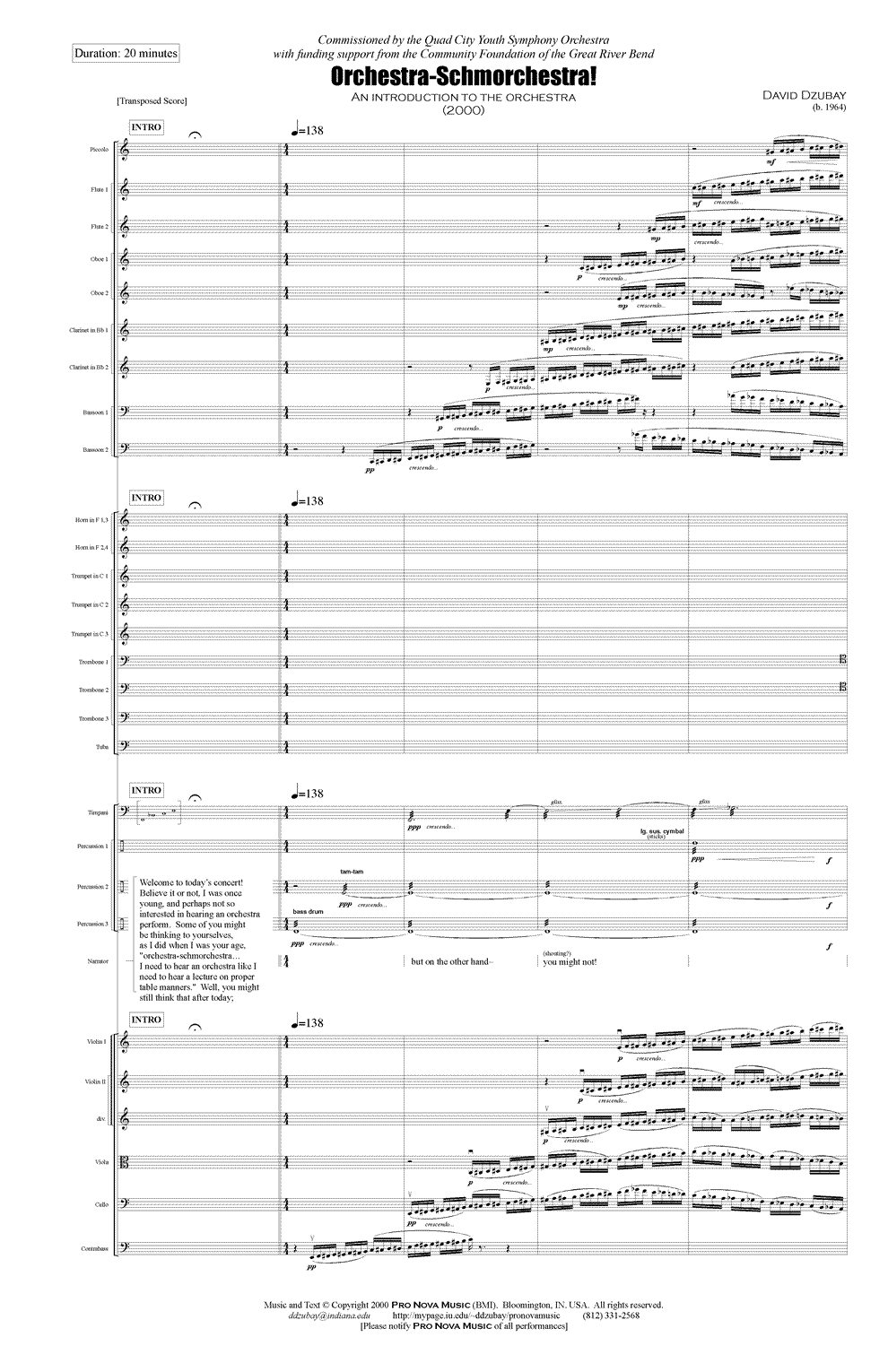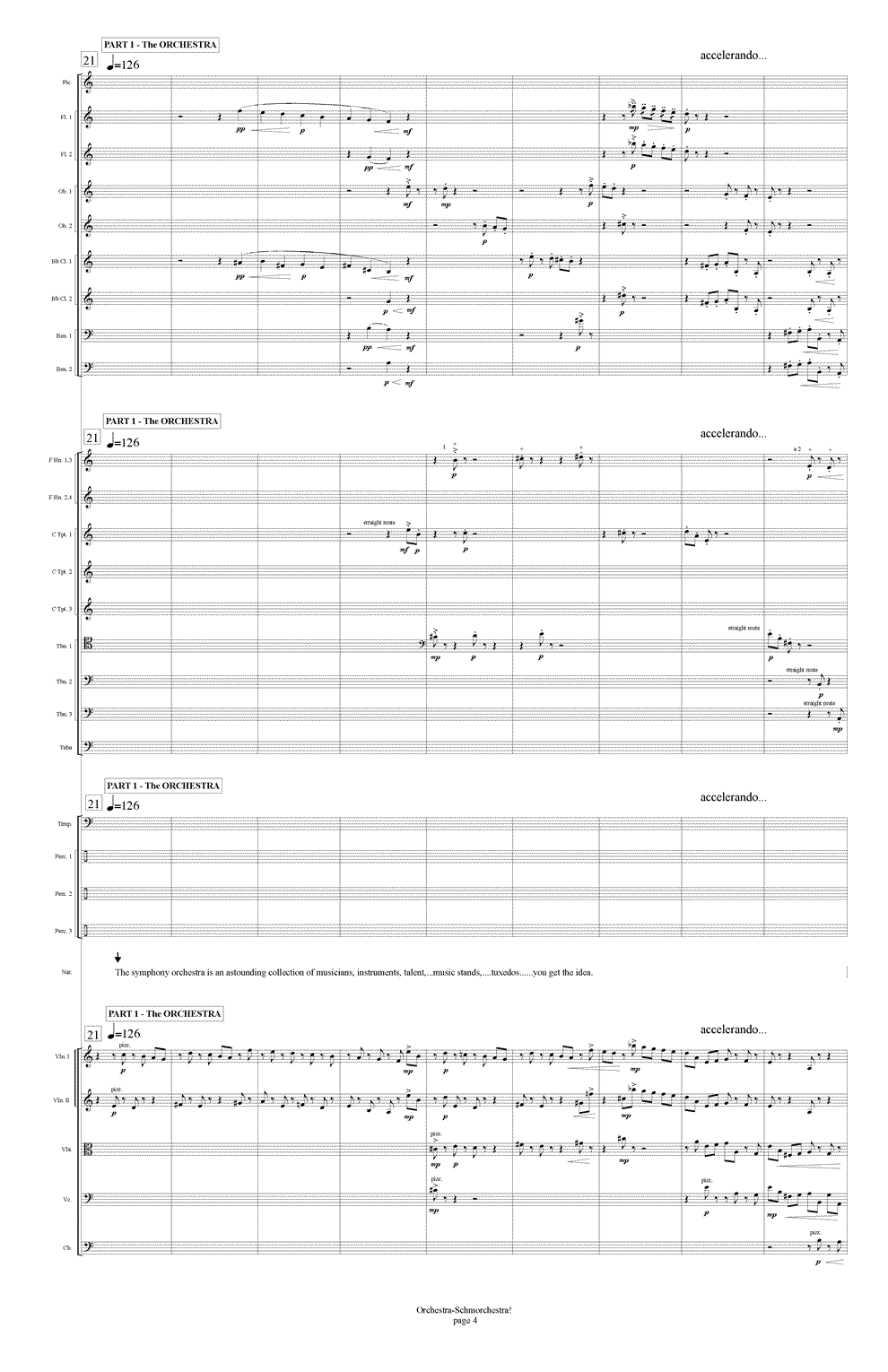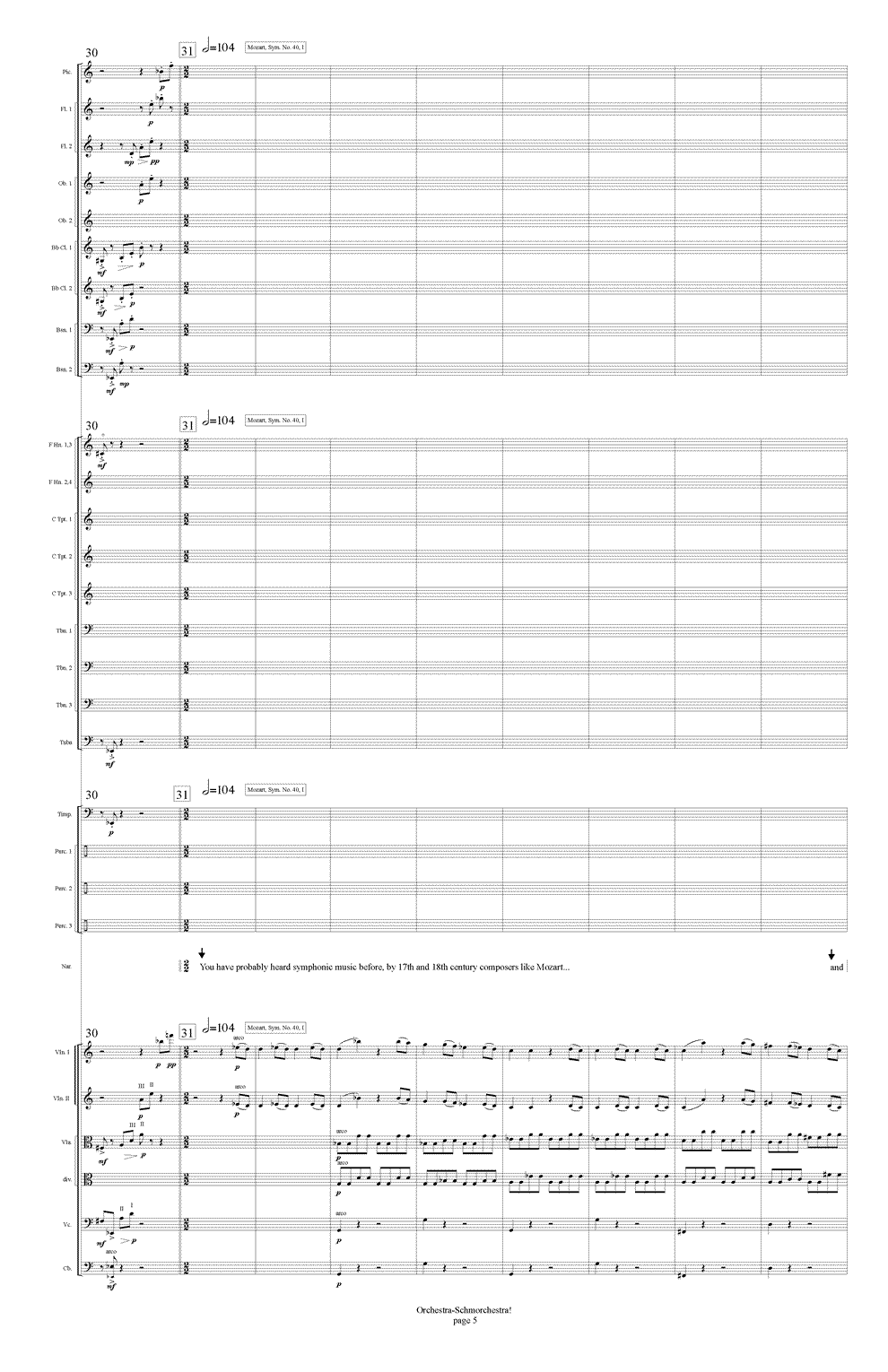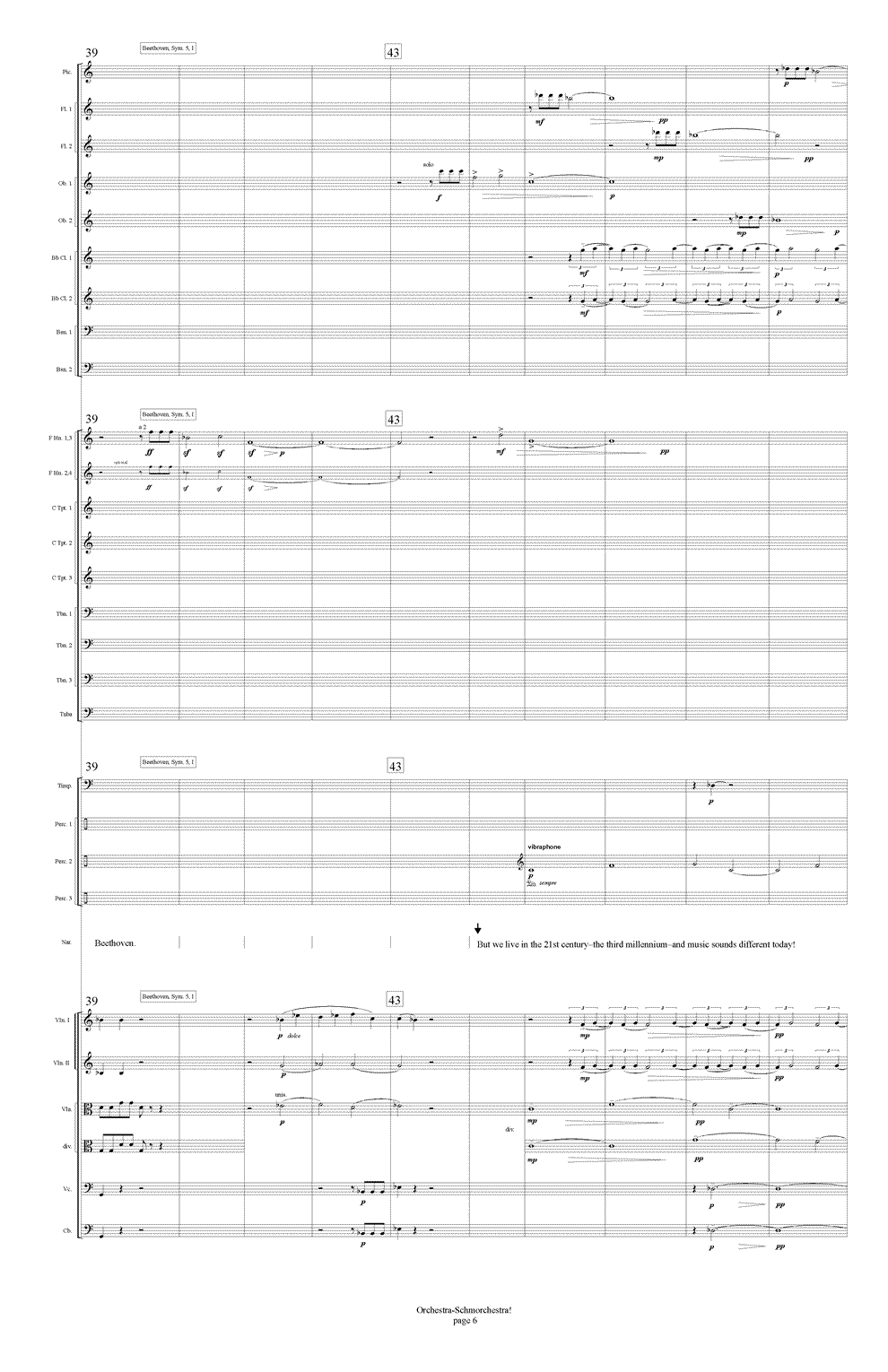Duration: 20 minutes
Instrumentation: Narrator + 3(3=pc)222/4431/timp.3perc/strings
Program Note: (to text) (to score)
PERUSAL SCORE (pdf of entire score...for web viewing only. If you need a hard copy printed, please order it from me).
RECORDING (live premiere, Quad City Youth Symphony on April 4, 2001, with Daniel Culver conducting and David Dzubay narrating)
Commissioned by the Quad City Youth Symphony Orchestra with funding support from the Community Foundation of the Great River Bend
Orchestra-Schmorchestra! aims to introduce young audiences to the orchestra and its instruments. With a mix of humor, historical background, and contemporary musical language, the work illustrates the sonic possibilities and characteristics of the orchestra, its four sections, and the individual instruments. Moving from the general to the specific, the composition is outlined as follows:
INTRODUCTION
Part I ‚ the ORCHESTRA
Part II ‚ the FOUR GROUPS
Part III ‚ the WOODWINDS
Part IV ‚ the BRASS
Part V ‚ the PERCUSSION
Part VI ‚ the STRINGS
Part VII ‚ the CONDUCTOR
FINALE
Though structured in something close to a variation form, this composition is not based on a pre-existing theme. Rather, to acheive a sense of cohesion, almost all of the music is related to two basic melodic ideas first presented in the introduction. The first is a short fanfare gesture emphasizing a minor sixth; the second is a four pitch chromatic cell ‚ two whole steps one half step apart. There is also some recurring "bridge music," taking us from one part to the next, and an emphasis on two keys: A and C (Both are used in the final cadence). (David Dzubay)
Premiere: Orchestra-Schmorchestra! was first performed by the Quad City Youth Symphony on April 4, 2001, with Daniel Culver conducting and David Dzubay narrating (David Dzubay is available for appearances as narrator).
INTRODUCTION: Welcome to today's concert! Believe it or not, I was once young, and perhaps not so interested in hearing an orchestra perform. Some of you might be thinking to yourselves, as I did when I was your age, "orchestra-schmorchestra...I need to hear an orchestra like I need to hear a lecture on proper table manners." Well, you might still think that after today; but on the other hand ‚ (shouting?) you might not!
PART I ‚ the ORCHESTRA:The symphony orchestra is an astounding collection of musicians, instruments, talent,... music stands,.....tuxedos........ you get the idea. You have probably heard symphonic music before, by 17th and 18th century composers like Mozart...and Beethoven. But we live in the 21st century ‚ the third millennium ‚ and music sounds different today! Composers, like painters and sculptors, don't just imitate the past, they strive to add something new to their art form. A symphony orchestra, with perhaps 75 to 100 or more musicians, offers a composer endless sonic possibilities. An orchestra can sound bombastic. An orchestra can sound intimate. An orchestra can sound romantic. An orchestra can sound angry. An orchestra can sound suspenseful. An orchestra can sound heroic. An orchestra can sound jagged. An orchestra can sound smooth. An orchestra can sound celebratory. An orchestra can sound active...still... bright... dark... loud... soft... high... low... and any other way a composer imagines.
PART II ‚ the FOUR GROUPS:Four groups of instruments make up the orchestra: woodwinds, brass, percussion, and strings. The musicians in each group practice countless hours perfecting the specific techniques their instruments require, from rolling...and blowing...to buzzing...and bowing.
PART III ‚ the WOODWINDS:At the top of the conductor's score we find the woodwinds, fleet-footed section of the orchestra, capable of great agility... and sometimes a bit light-headed from the constant exhaling required to play their intruments. There are four types of woodwinds, each with a unique sound: bassoons, clarinets, oboes, flutes. When combined, the distinct sounds of the woodwinds can blend in effective ways, producing everything from warm chorales... to powerful exclamations.
PART IV ‚ the BRASS:Next, the brass: to some, simply glorifed garden hoses... to others, shining symbols of triumph. As with the woodwinds, there are four sorts of brass instruments: horns, trumpets, trombones, and tuba. In early orchestral compositions, brass instruments were grouped with the percussion...(disapproving look at perc.) mainly timpani!...and usually served a supporting role, because before the development of valves, they could only play a few different tones. We get the point! In 1814, two Germans ‚ probably bored brass players ‚ thought of equipping brass instruments with valves, which when depressed vary the length of the hose, ...er...tubing, making trills, scales and other outrageous displays possible.
PART V ‚ the PERCUSSION:The percussion instruments are played by striking two or more objects together, like a stick and drum... two cymbals... or even (quickly:) a stick, a mallet, a drum, and a cymbal. In older orchestral music, percussion is used for occasional color or dramatic effect. But in the last century ‚ the 20th century that is ‚ composers started giving the percussion section more prominence, calling for a greater number of instruments and a wider range of skills than before. Percussionists can make loud noises, but they create quiet, delicate sounds as well. There are four types of percussion instruments: metals, woods, skins, and what we might call "other." Percussionists often play so many different instruments at once that they actually choreograph their movements between instruments.
PART VI ‚ the STRINGS:At the bottom of the score we find the strings ‚ the heart of the orchestra. Care to guess how many kinds of string instruments we have in the orchestra? That's right ‚ four!: Basses, Cellos, Violas, and Violins. While the wind, brass and percussion players have individual parts to play, the strings in each section usually play the same music; though at times the section gets divided into two... three... or even sixteen!
PART VII ‚ the CONDUCTOR:Though he doesn't usually make any sound, the conductor is an important part of the orchestra. As leader of the orchestra, the conductor controls tempo...(exagerated, toward orch.:) I said, the conductor controls tempo... as well as dynamics and balance. In some contemporary music, the conductor might even improvise, choosing when each group will play.
FINALENow for a Grand Finale! If you listen closely, you will hear the return of earlier passages, you will hear the different groups of the orchestra both competing and cooperating, and you may even leave here today with more running through your thoughts than just "orchestra-schmorchestra!"





